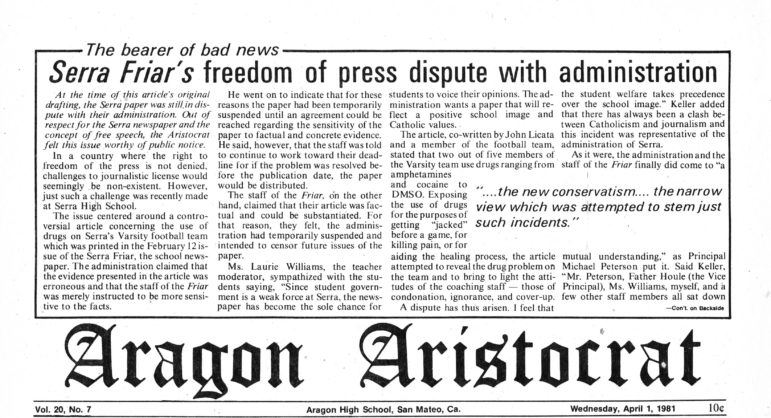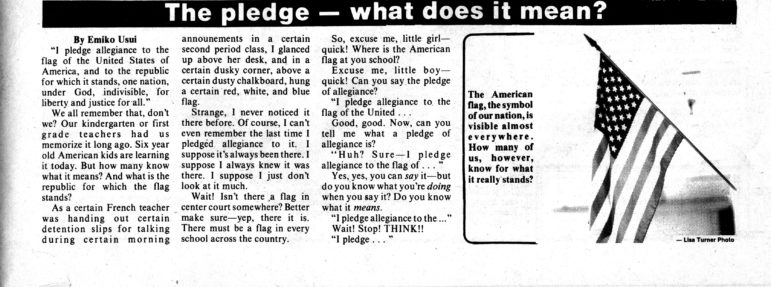The Aragon Aristocrat, the former name for the Outlook, published a centerspread titled “Students’ Rights” on March 25, 1988. It discussed issues from First Amendment rights on school grounds to the jurisdiction school administration had to search a student’s belongings.
One segment of the centerspread was titled, “Take a late lunch — break the law.” The blurb examined the consequences of going off campus during school hours — even during lunch or breaks — which was and still is not allowed at Aragon. In 1988, however, the administration was much stricter with truants, even employing truancy officer Mike Romero to look for students who were cutting class.
The piece summarized truancy policy at the time as, “during school hours, the police have the right to pick up any students they see on the streets, even if he [sic] is not breaking the law in any way.” Aragon’s 2017-2018 student handbook has similar language, but specifies that students can be returned to school “if they are loitering in neighboring areas.”
The spread also discussed the First Amendment rights of students. Their First Amendment rights was a hot topic at the time because in January of 1988, the Supreme Court decided in Hazelwood v. Kuhlmeier that administrators could excercise editorial control over student papers if said control was “reasonably related to legitimate pedagogical concerns.”
In the spread, student opinion on the issue of free speech was roughly uniform, with most against any restrictions of expression by the school.
A senior, Bryan Smith, said, “No way [the school has the right to censor students]. Not at all. Not one bit …. We should be able to write whatever we want without any interference.
Another concurring opinion came from sophomore Alex Wellman, who said, “[The school] absolutely does not [have the right to censor students]. I think that the writers of the Aristocrat should have the same freedom granted to them that any adult American citizen has as far as freedom of speech.”
One opinion stood out, however, and that came from Stephan Jew, a junior, who said, “I think that the school has a right to censor the paper in its own protection, but the school should give the paper enough freedom so it doesn’t feel confined.”
California has since passed legsilation that generally prevents administrations from exerting editorial control. Student support of high school papers did not just come in response to Hazelwood, thought.
A 1981 Aristocrat article, “Serra Friar’s freedom of press dispute with administration,” covered Serra High School’s administration refusing to allow the school paper to print an article about drug use on the varsity football team. The administration said that the refusal was due to factual inaccuracies in the article, but the paper’s staff contended that the article was truthful.

The Aristocrat’s coverage of the incident included the thoughts of the Serra paper’s teacher moderator Laurie Williams, who said, “Since student government is a weak force at Serra, the newspaper has become the sole chance for students to voice their opinions.”
Evidently, as seen in the national news throughout the late 20th century, issues of students’ rights were alive in San Mateo as well, bringing close to home what was seen as a national topic.
Another national topic that saw localization in Aragon’s newspaper is the meaning of patriotic displays.
A column from 1982, “The pledge — what does it mean?” criticized the common practice of reciting the Pledge of Allegiance in class.
The piece questioned, “Our kindergarten or first grade teachers had us memorize it long ago. Six-year-old American kids are learning it today. But how many know what it means? And what is the republic for which the flag stands?”

It concluded with a mimicked conversation, which went, “Yes, yes, you can say it — but do you know what you’re doing when you say it? Do you know what it means. [sic] ‘I pledge allegiance to the…’ Wait! Stop! THINK!!”
This resistance is echoed in the recent phenomenon of NFL players kneeling during the National Anthem. Like the author of the column prompted, the players thought about why people stand during the Anthem, and consciously decided instead to kneel.
The column is telling of a decade in which Aragon faced and discussed a rash of issues concerning the rights of students, following events in the ‘70s which awakened student activism and discussion. A look at the 1980s, as it turns out, is a look at a time when Aragon students discussed, learned, and fought for their rights.




